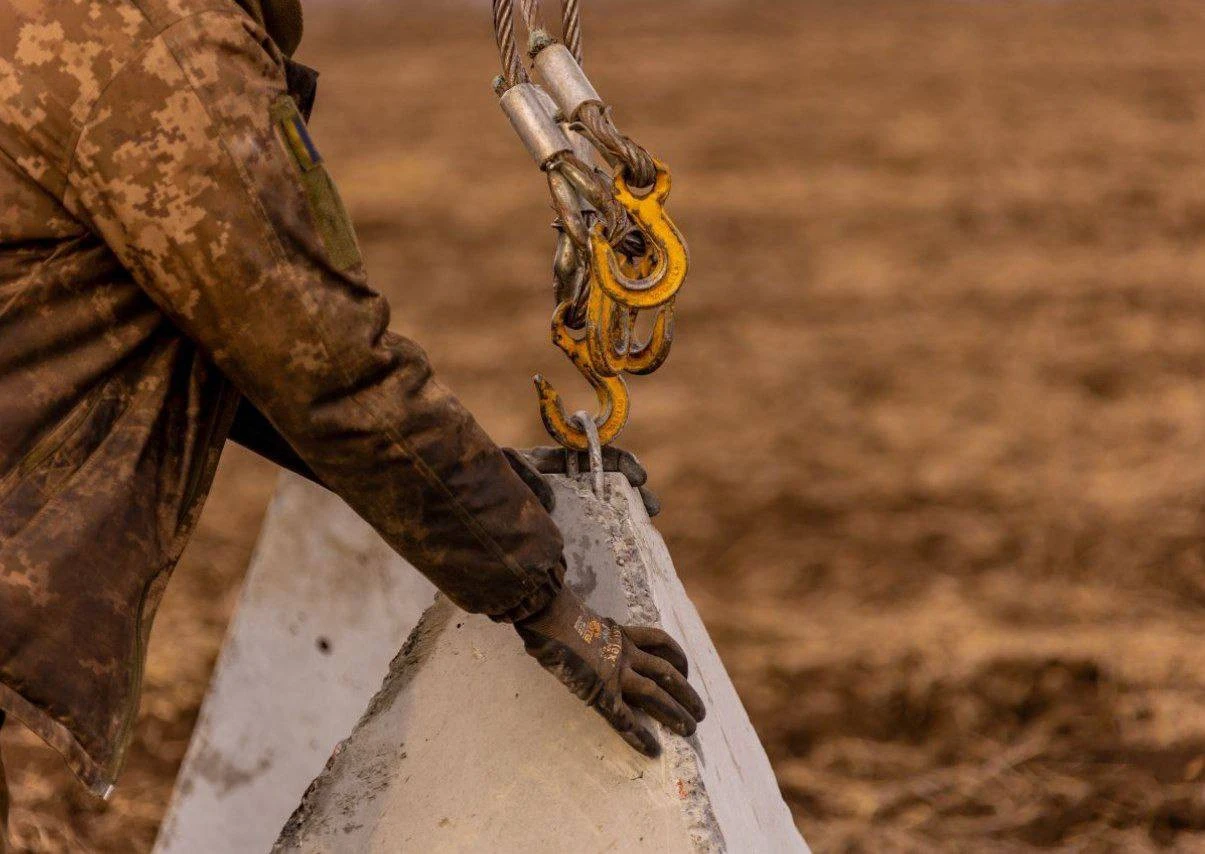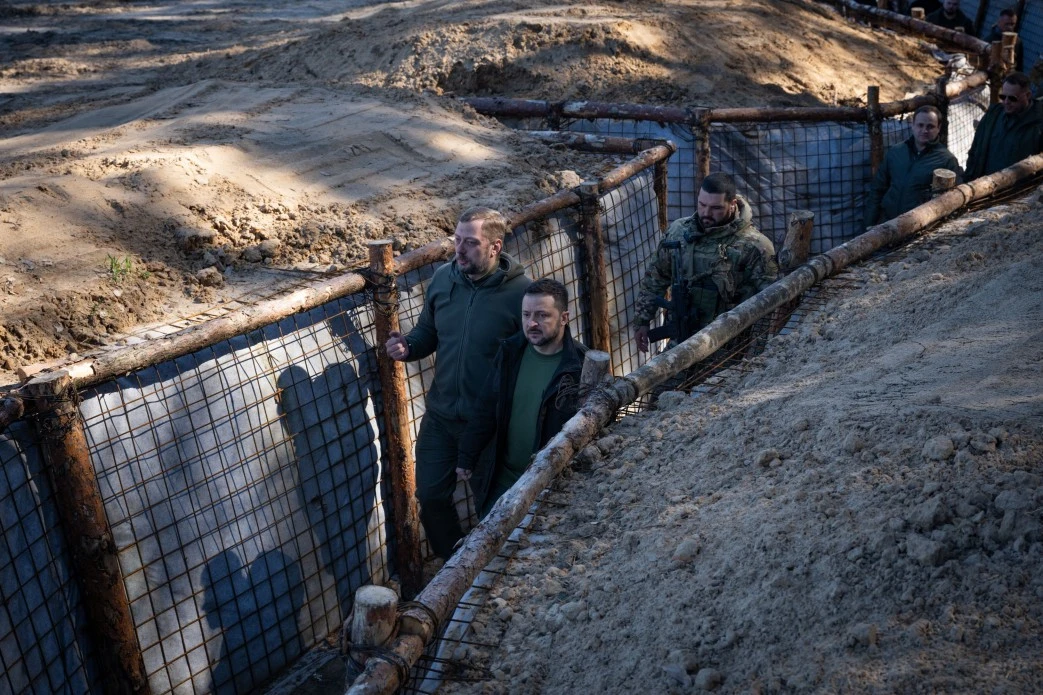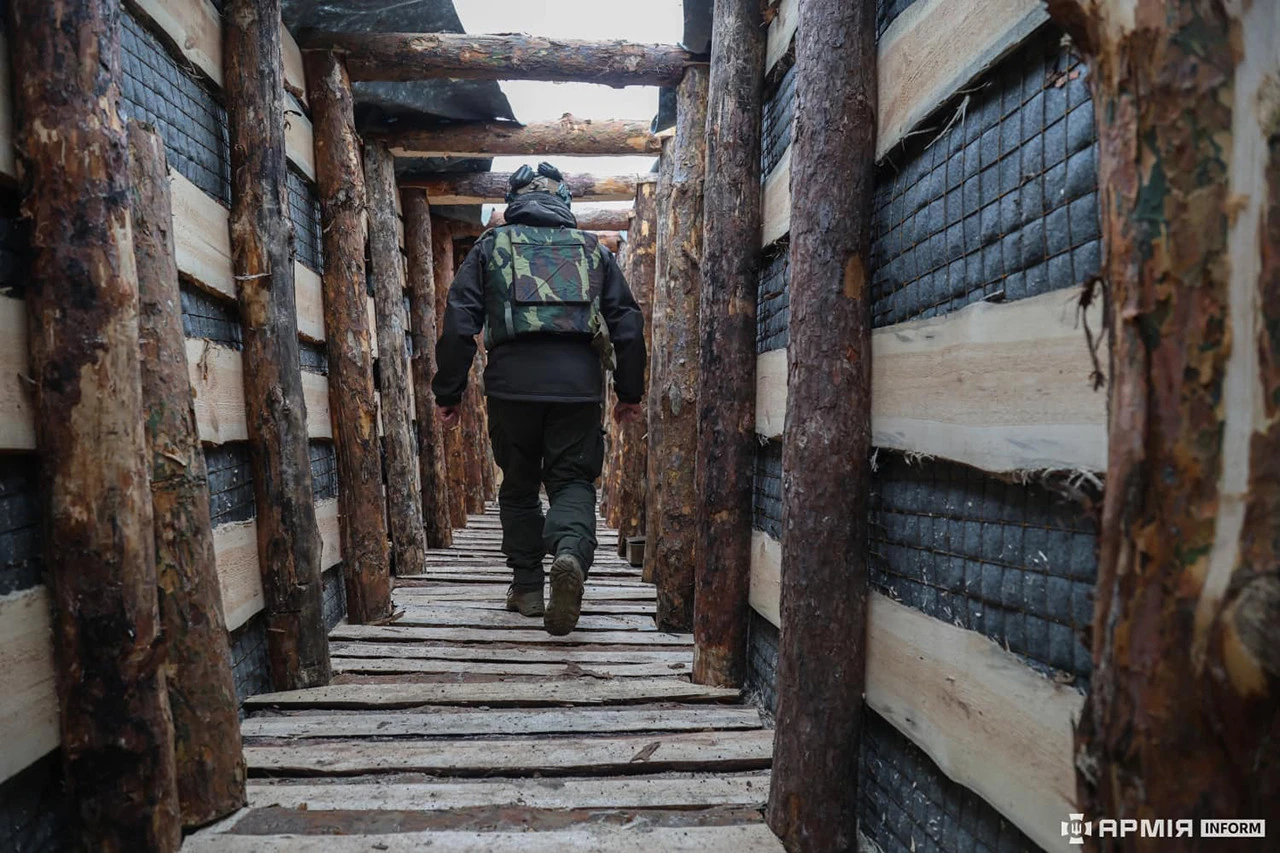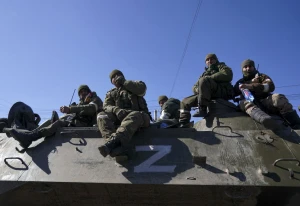
Why and how is Kyiv building fortifications during third year of full-scale war?
Recently, Ukrainian President Volodymyr Zelenskyy visited the Chernihiv region to inspect the construction of fortifications and said that work in some 'hot' areas was almost complete. However, why has this become the No.1 issue now?
Espreso will tell the story of the history and military significance of the fortifications and how they have become critical to the current situation at the front.
What's in the article:
- History of the development of fortifications
- Why did Ukraine start building fortifications on a massive scale
- Who is engaged in fortifications and how much money has been allocated for this
- What are the difficulties associated with the construction of fortifications?
History of the development of fortifications

Photo: Wikipedia
For thousands of years, walls have been a condition for the survival of large groups of people. They enclosed their settlements and cities to protect themselves from enemies. At first, these were wooden fortifications, and later - stone walls with towers. Over time, they were developed to a huge scale (for example, the Great Wall of China stretches for almost 9,000 kilometers and was created to protect against barbarians from the north), and in the Middle Ages, large impregnable castles were built en masse (the walls of the Khotyn fortress are 40 meters high). All over Europe, local schools of defense architecture were operating, looking for ways to make their fortifications impregnable. The ancient Roman architect Vitruvius called it "the art of combining function, design, and beauty." After all, in addition to attack, there is also defense, which is also a military art.
With the development of artillery and the emergence of centralized armies and later mechanized brigades, huge fortification lines were built and developed, including various engineering solutions (for example, the famous 400 km Maginot Line was supposed to protect France from the Germans). These can be buildings, bastions, walls, ditches, trenches, ramparts, high towers, dugouts, bunkers, and so on, placed along the area where the enemy can attack. The purpose of fortifications is to deter an offensive, facilitate defense, and allow you to prepare your troops to drive off enemies. Fortifications are a branch of military engineering.
According to experts from Ukraine's National Defense University, the development of defense structures has always kept pace with the improvement of weapons and tactics. In the era of swords, fortifications were based on fences, ramparts and ditches, which made it difficult for the enemy to attack and storm them. With the advent of firearms and linear tactics, redoubts (strongholds) appeared in the system of fortifications. With the increase in the power of small arms and artillery, the basis of fortified positions and strongholds began to be trenches (bastions, lodges), trenches, wood and concrete structures. In the days of mechanized and tank troops, industrially manufactured sets of defensive structures (reinforced concrete and metal) that could be easily assembled and disassembled were widely used. And the more powerful the bombs became, the stronger and deeper the bunkers and tunnels became.
According to their purpose, fortifications are divided into:
- facilities for firing (trenches, trenches, etc.)
- observation and control (observation and command posts)
- protection of personnel (crevices, dugouts, shelters), military equipment and material resources (pit shelters, closed shelters)
- communication shelters (communication passages, rubble - galleries underground or inside the structure).
Why did Ukraine start building fortifications en masse?

Photo: https://t.me/dnipropetrovskaODA
Under the Soviet Union, the main threat was seen as coming from the west, and the country developed its defense and deployed its bases and other military enterprises accordingly. However, with the collapse of the USSR, all this became irrelevant. Until early 2014, Ukraine did not consider the possibility of an attack on the country from the east. However, Russia's annexation of Crimea and the creation of an artificial war in Donbas radically changed Ukraine's military strategy.
For the first time, the construction of large-scale defense on the eastern borders was discussed in the summer and fall of 2014. This project was called The Wall. According to the Defense Ministry, the barrier was not supposed to stop heavy armored vehicles, and the fortifications were to be "to increase the level of border security: to ensure monitoring, visual surveillance and deter illegal border crossing by smugglers and sabotage groups." However, almost immediately, the initiative was mired in various scandals and anti-corruption proceedings over the embezzlement of public funds. By the beginning of summer 2021, The Wall was half completed, and just before the full-scale invasion, the project was supposedly completed. But in reality, The Wall was too short. The border was never completed in many regions of Ukraine. "The construction of engineering structures was carried out in parts of the Kharkiv, Luhansk, and partially Chernihiv regions," the State Border Guard Service explained to Telegraf.
What was done under The Wall project before the start of the full-scale war:
- 403.5 kilometers of 4 by 2 meters anti-tank ditches were dug (instead of the planned 1,134 kilometers)
- 158 kilometers of barbed wire fence were built (instead of 194 kilometers)
- 185 kilometers of rocky roads were built (instead of the planned 1,129 kilometers)
- 11 video surveillance systems were installed (instead of 51)
- 4 checkpoints were set up (instead of 120).
As we can see, this project was never fully implemented. The situation was better in those areas where the Anti-Terrorist Operation and later the Joint Forces Operation against pro-Russian separatists in the Donetsk and Luhansk regions were operating.
"Three defense lines have been built in the ATO zone for almost a year, at a cost of about UAH 850 million: 300 defensive structures, 600 kilometers of fortifications, 12,000 concrete structures," writes Slovo i Dilo.
Since 2014, the military has managed to build a defense line in the Donetsk region, which, to a greater extent (except in the south), was able to cope with a full-scale invasion, becoming a fist against which many waves of enemy attacks crashed. The situation was quite different in the Luhansk region, where the absence of a defense line on the border allowed Russian troops to quickly occupy almost the entire region.
Since April 2022, when the Russian forces were driven out of northern Ukraine, the main theater of operations has been focused on the eastern direction. For the second year in a row, the Russians have been claiming that they are completely encircling the Luhansk and Donetsk regions from month to month, but despite these statements, the invaders are slowly advancing, and fierce fighting in Sievierodonetsk, Bakhmut, and Avdiivka is evidence that Ukraine has enough forces to hold back the enemy's superior forces. In fact, the last additional defense lines to fall recently were Marinka and Avdiivka.
Since the end of last year, the Ukrainian information space has been talking more and more about the construction of new powerful fortifications. What has changed and why hasn't everyone heard this word before? There are several reasons for this:
Military strategy. War consists of both offensive and defensive actions. In the first half of 2022, Ukraine was on the defensive, but when we managed to break the Russians' poorly thought-out plan to take Kyiv in three days, we managed to take them by surprise and launch an offensive in the fall. By the end of 2022, the Ukrainian Armed Forces had regained Kharkiv and part of the Kherson regions. From winter to summer, Kyiv planned to maintain its offensive momentum and was preparing a major counteroffensive in the south. However, in six months, the Russians were able to prepare and build their defense lines (various fortifications and mine vast areas). As a result, the defensive position of the Russian forces proved to be better than the offensive position of the Ukrainian Armed Forces, so last summer's long-awaited powerful counteroffensive did not bring the expected results. After that, the Russians began to plan their offensive, which began near Avdiivka at the end of 2023. The Defense Intelligence of Ukraine expects that in early summer Russia will launch another massive offensive on one of the directions to break through the Ukrainian defense line.
"It seems that in order to believe in the need for fortifications, we needed to hit the Surovikin line in the south," Yevhen Dykyi, a veteran of the Russian-Ukrainian war and former company commander of the Aidar battalion, told Radio Liberty.
Help from allies. The United States has been and remains Ukraine's key military ally. It was the Americans who provided Ukraine with about $45 billion in military aid, ranging from weapons to ammunition. However, in two years, the allocated money ran out. Therefore, in the fall of 2023, US President Joe Biden submitted a bill to Congress for an additional $60 billion for Ukraine. However, for more than six months now, this issue has been a bone of contention between Republicans and Democrats. The favorite in the presidential race, Donald Trump, has been adding fuel to the fire. As a result, Ukrainian troops have been suffering from a shell famine for months, lacking artillery and other military equipment, which allows the occupiers to advance and destroy Ukrainian positions. Although the Europeans want to replace our dependence on American shells, they have had little success so far.
Ukraine's internal capabilities. War requires a competent allocation of resources. The longer it lasts, the greater the impact on the economy and social life. During the two years of full-scale war, Ukraine has faced significant challenges and it is becoming increasingly difficult to predict how to live further. The war is consuming more and more money, and the economy is shrinking. But most importantly, human resources are also dwindling. Millions of Ukrainians have left and this has reduced the domestic market. There are about a million people in the army, and an active mobilization campaign has been launched since the fall of 2023 to draft hundreds of thousands more Ukrainians. This means an even greater reduction in economic resources and the search for billions to pay recruits' salaries.
So, at the moment, Ukraine is in a situation where, at least this year, it has no opportunities to launch a large-scale offensive and regain the lost territories, so it is forced to be on the active defense. This means protecting its borders, including through fortifications that can stop the advance of Russian troops. In fact, the active phase of their construction began at the end of 2023, when the Russians went on the offensive and we went on the defense. In December last year, President Zelenskyy began to speak openly about the start of construction of fortifications across the country. And the rapid advance of the Russians near Avdiivka showed how the lack of appropriate fortifications can quickly change the military initiative.
"Fortifications are now a condition for the existence of the state. I first stated this in early August 2023 and was fiercely attacked. Do you know why? Because my proposal to build fortifications prevented them from advancing. They said that if we start talking about fortifications now, everyone will think that we have stopped attacking," former President of Ukraine Petro Poroshenko said in mid-March.
Who is engaged in fortifications and how much money has been allocated for this?

Photo: President’s Office
While the military used to make defensive lines on their own, digging trenches and creating makeshift dugouts, since the beginning of the year the Ukrainian government (State Special Transport Service and the State Agency for Infrastructure Restoration and Development), together with local authorities, has been actively taking this initiative to build fortifications as soon as possible. For this purpose, the capacities of the regions in the rear were used. One can find many reports from regional administrations about how construction companies in western, northern and central Ukraine are engaged in these works.
According to the Nashi Groshi publication, while before February of this year (when Russia captured Avdiivka), only UAH 0.64 billion worth of fortification orders were placed for the year, in just a month and a half after that, another UAH 17 billion was ordered.
"Fortification orders in the structure of the Defense Ministry began in late February, when Defense Minister Rustem Umerov hired former Deputy Head of the President’s Office Kyrylo Tymoshenko as his advisor. Sources of Nashi Groshi report that Tymoshenko was hired to improve the communication component of the Defense Ministry, which, according to Volodymyr Zelenskyy, was in poor condition. He will also coordinate the construction of fortifications," the publication writes.
The same information about the involvement of the scandalous former coordinator of the Big Construction project, Kyrylo Tymoshenko, in adjusting the process of building fortifications was confirmed by BBC Ukraine.
On April 2, the Cabinet of Ministers announced that it was allocating almost UAH 6 billion more for the construction of fortifications.
"This year, the government has already allocated UAH 20 billion for the construction of reliable fortifications. Today we are adding another UAH 5.6 billion," said Prime Minister Denys Shmyhal.
That is, the total amount allocated in Ukraine for the construction of fortifications as of the beginning of April is almost UAH 26 billion. The fortifications are being built in all regions of Ukraine that border both Russia and the Ukrainian territories it has seized, as well as Belarus.
"The defense in three lanes with a length of 2,000 kilometers is a large-scale task, but the pace is good now. I am looking forward to its timely completion," President of Ukraine Volodymyr Zelenskyy said in early March.
So, we are talking about 2,000 kilometers, where we need to make not one line of defense, but three - as the rules of the classic defense line say:
The first is a strip called the "foothills". That is, everything that goes before the main line of fortifications. Such a strip is usually up to 5 km long and contains a large number of mine and landmine obstacles, as well as "dragon's teeth" and various hidden objects that should prevent the enemy from advancing deeper into the controlled territory;
The second line is the main line. The 15-kilometer-wide line primarily consists of reinforced concrete and granite long-term defensive points (strongholds), trenches, and other fortifications. Reserve troops or additional artillery positions may also be placed in this line. This line is used for maneuvering.
The third line of defense is the rear line in most cases. It provides the first and second lines with everything they need. It can also include strategic reserves, additional defensive structures, as well as command and logistics points. The rear line of defense is intended to be the last line of defense in case of a breakthrough of enemy forces through the front and middle lines.
Military expert Oleksandr Kovalenko told Zaborona that Ukrainians are building powerful fortifications similar to those made by Russians in the south.
"According to the classical formulation, we are building three lines of defense. No one can say what they will look like in reality. We can assume that in some ways they will be similar to the Russian ones. When Ukrainian troops launched an offensive in the Zaporizhzhia region in 2023, they faced a very hypertrophied first line of the enemy. There were up to five mines per square meter of territory, both anti-tank and anti-personnel mines. This has not happened since the Second World War. That is why we are now using very similar techniques," the expert said.
What are the difficulties associated with the construction of fortifications?

Photo: armyinform
First of all, we need to understand that the construction of fortifications often takes place close to the contact line. This means that they are targets for enemy strikes. That is why the locations of the fortifications are not disclosed in order to save the lives of workers and to allow them to be completed in time.
It should also be remembered that construction companies and regional administrations do not have the appropriate military specialists to build high-quality fortifications on their own. They only help the engineering military units that belong to the Armed Forces and control the construction of these fortifications. Since the early 2000s, these troops have been reduced, and there is a lack of specialists who could speed up the planning of the three defense lines.
"Experts emphasize that during the reduction of the Ukrainian army, which took place before Russia's attack in 2014, the engineering troops were among the first to suffer: excavators, bulldozers and other equipment were sold as so-called surplus army property. Now they are critically lacking," Radio Liberty writes.
But perhaps the biggest problem is the lack of time and bureaucracy. Although with money, workers, equipment, military engineers and sappers, the construction of three defense lines can be done in a few months (the same Russians were able to do it in six months in the south), as Serhii Rakhmanin, a member of the Parliamentary Committee on National Security and Defense, told Radio NV, we often have "no one on the ground to slam a fist on the table" to coordinate the work.
"If the military negotiates with the local authorities, they will give something, if they don't, they won't. And the answer is very common: "You will lose it anyway, you will break it or it will explode, and therefore we will not give it to you." There are a lot of such cases," Rakhmanin said, referring to bureaucracy and the issue of subordination, which is often a problem at the level of relations between the military and local authorities.
Another problem for the development of fortifications, as BBC Ukraine journalists found out, is that in the third year of the war, there is still a "private border" on the borderlands of Ukraine. That is, large areas that do not belong to the government but are owned by private entrepreneurs or local residents.
"In March, the owners of land in one of the settlements in the Rivne region came out to the group that was building the fortifications and made an ultimatum: "We will not allow this, we will stand as a human shield!"... The military and local authorities we spoke to do not rule out the possibility of such conflicts escalating, especially on the eve of the sowing season. And all because Ukraine has not resolved the issue of returning strategically important defense lands near the border to the state for decades," BBC Ukraine notes.
- News












































